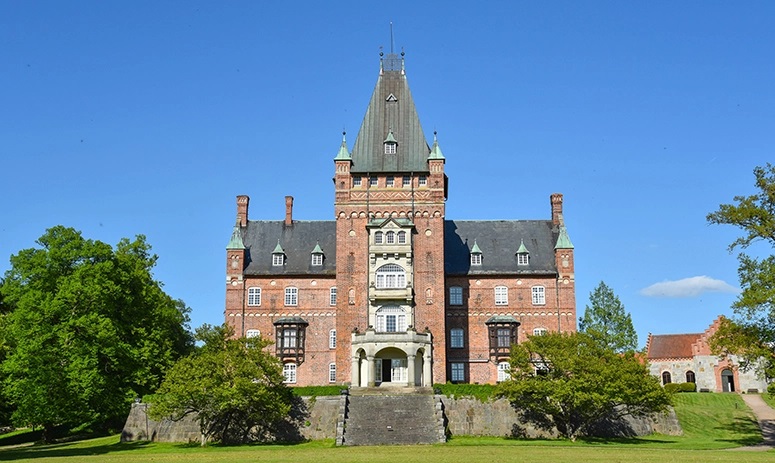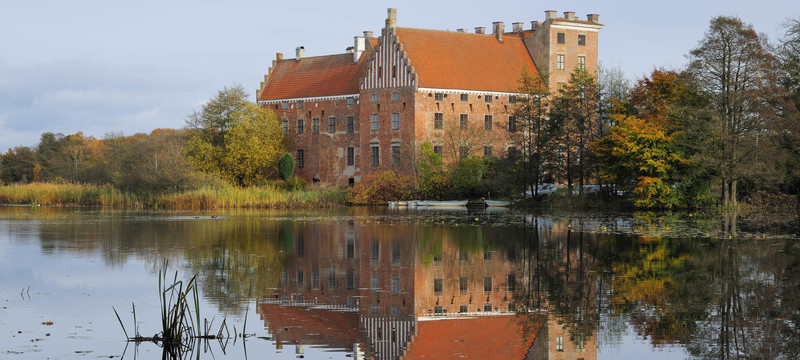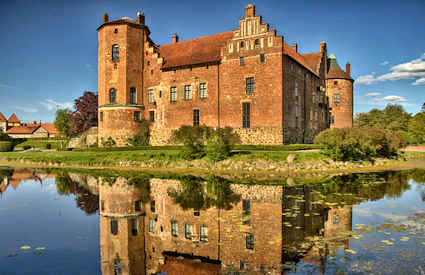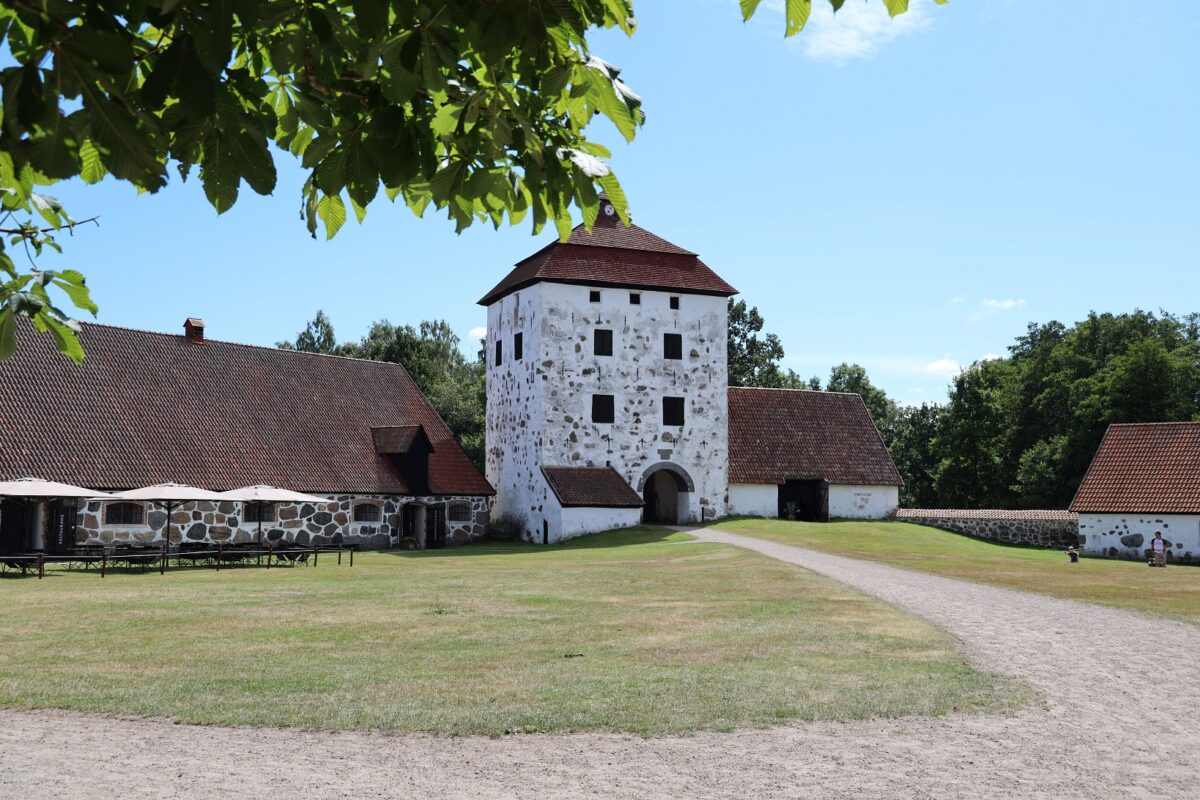Trollenäs Castle
Trollenäs Castle was built in the 16th century, but the place has been mentioned since the end
of the 14th century when there was a farm owned by the knight Stig Aagesen Thott.
The property is further inherited within the Thott family until 1682, when Knut Thott entered
into an exchange deal with Helle Trolle.
Trollenäs is still privately owned and is still owned by the Trolle family.
A troll with a severed head is depicted on one wall at Trollenäs. It symbolizes the noble coat
of arms of the Troll family.
It is said that the ancestor of the Trolle family, Gunnar Gröpe who lived in the 9th century,
haunts in the form of a large black dog with shining eyes. The dog usually shows up in the
basement.
Trollenäs castle is located in Trollenäs, in Eslöv municipality, Skåne.
In the summer, the castle café Borgstugan is open in the castle park, which is also open for
visitors to walk around in. A guided tour of Trollenäs castle can be booked.
Bosjökloster Castle
Bosjökloster Castle is a medieval castle and former nunnery that was probably founded for
Benedictine nuns in the early 12th century.
The oldest document that mentions Bosjökloster is a letter from Pope Lucius III in 1181, in
which he
confirmed the monastery's privileges.
For several hundred years the nuns lived here. The monastery received many rich donations but
the
sisters themselves lived according to the strict rules of obedience, poverty and chastity.
During the Reformation in the 16th century, the monastery was gradually closed down and much of
its
wealth was confiscated.
Since 1560, Bosjökloster has been in private ownership. It was opened to the public as early as
1962
and is today run by the Bonde family.
Bosjökloster castle is located approximately 6 km south of Höör in Skåne and is located on the
southern shore of the Ringsjön peninsula, which in ancient times was an island.
As a visitor, you can walk around the castle and discover over 900 years of history from
nunneries
to today's castle and gardens.
Several events are also held during the year, such as Skånes Christmas Days and Skåne Country
Life
Days. Every summer, the annual “Musik” concert is also held at Bosjökloster.
Svaneholm Castle
It is believed that Svaneholm's predecessor was a manor which was located by Skurup's church and
which in 1530 was moved by Mourid Jepsen Sparre to the islet where Svaneholm is today.
According to tradition, they got the name Svaneholm after the swans that nested there on the
islet.
Svaneholm Castle is located in Skurup's parish in Skurup's municipality in Skåne.
Today its operated as a castle museum. Among other things, there is an exhibition that describes
all
the ghosts that haunt the castle.
The entire museum includes over 13,000 objects and clothing.
A very interesting place to visit for those who want to immerse themselves in the history of
Skåne.
At Svaneholm Castle there is also the Macklean room with an exhibition about Rutger Macklean.
Guided tours are offered and there is also the option of walking around on your own with an
audio
guide. At Svaneholms there is also a castle restaurant and Café.
Torup Castle
Torup Castle is a well-preserved Renaissance castle with a beautiful castle park located next to
Torup's beech forest.
The current castle was built in the 16th century and then restored in the 17th century.
On Sunday 27 May 1775, four young people drowned in the lake at Torup. It was the heir to
Trollenäs,
Fredrik Trolle and his two sisters and their young aunt who, after a dinner at Torup's castle,
rowed
out on the lake in a small oak tree that sank. Many of the other guests at the castle heard
their
cries for help but no one managed to save them, despite contemporary accounts claiming that 'the
lake was so shallow that you could hardly hide in it'.
From 1811 to 1954, Torup had six different owners. In 1812, Gustaf Julius Coyet (37) bought the
castle and had canals excavated and laid the foundation for the park that is there today.
In the 1970s, Torup was sold to the city of Malmö, but the last owner's survivors today lease
the
castle from the city.
Torup's castle is located in Bara, in Svedala municipality in Skåne.
Visitors are welcome to stroll around the castle park. Guided tours are available during the
spring
and can be booked in advance.
At other times of the year, Torup Castle is only open in connection with various events and
exhibitions. However, the castle park is open all year round.
Glimmingehus Castle
Glimmingehus got its name from the shimmering lake that was on the site where the knight Jens
Holgersen Ulfstand in 1499 started building this mighty and impregnable castle, which today is
said
to be the best-preserved medieval castle in the Nordics.
Something that is particularly distinctive about this medieval castle is all of the defenses
that
have been preserved, such as false doors, parapets, holes for pouring boiling tar and other
kinds of
death traps for intruders.
Gradually, the castle lost its importance, and as it was also too uncomfortable and downright
unhealthy to live in, it was instead used as a granary by the farmers in the area.
Glimmingehus is located in Vallby, in Simrishamn municipality in Skåne, about 1 mile southwest
of
Simrishamn.
Glimmingehus is open to the public with the possibility of guided tours. In addition, a variety
of
activities are organized such as ghost walks, medieval days and jousting games.
Hovdala Castle
Hovdala Castle was built in the 16th century and dates back to the Middle Ages.
The castle had a particularly important role in the wars between Sweden and Denmark.
The mighty tower bears the year 1600 on the facade. The gate to the tower still bears traces of
the
fierce battles fought in the early 17th century.
The Swedes then attacked Hovdala during the Kalmar War.
Even during Skåne War 1675 - 1679, the castle was in bad shape and was partially burned down on
August 7, 1678. It was rebuilt by its then owner Jens Mikkelsen.
In 1687 he was ennobled Ehrenborg by Charles XI, as thanks for his services during the war.
Since then, the Ehrenborg family has lived at Hovdala for 9 generations until the beginning of
the
1980s.
Hovdala (also Hofdala) castle is located approximately 7 km south of Hässleholm, Skåne.
Nowadays, Hovdala Castle is open to the public and tours are offered during the summer. There is
also a restaurant and café.
The annual medieval days are something else that Hovdala Castle has become known for nowadays.
Hovdala Medieval Days are arranged every year during Ascension Week.





